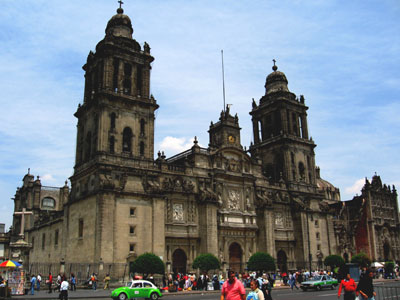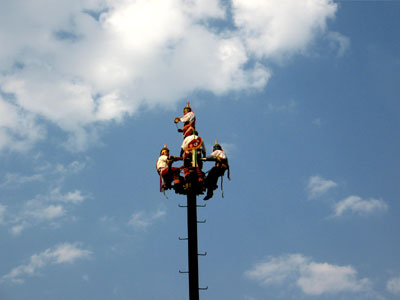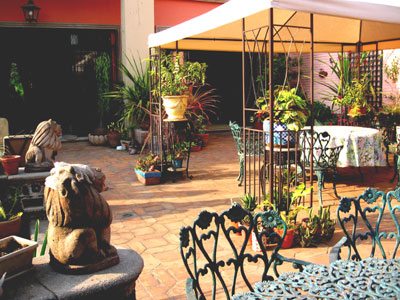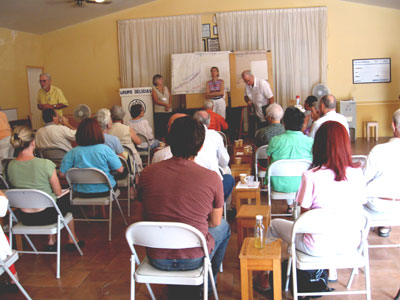After our visit to the huge government-owned pawnshop, Nacional Monte de Piedad, we saw a side view of Mexico City’s and Latin America’s biggest cathedral: the Catedral Metropolitana. It is also at the heart of the world’s largest Catholic diocese. Due to the fact that Mexico was built on the former Lake Texcoco, the cathedral is slowly sinking and scaffolding in the interior of the building attests to the efforts to try to stabilize it.

Mexico City’s Catedral Metropolitana
In front of the Cathedral are numerous merchants that sell all sorts of handicrafts to the tourists. The wide open public space in front of the church is called the Zócalo and it is said to be the second largest public square in the world, after Red Square in Moscow. An indigenous healer was performing a cleansing ceremony in public with a local couple. He had a variety of herbs and was burning incense for this purification ritual.
To the left side of the cathedral is the Palacio Nacional which today houses the office’s of Mexico’s president. One of the typical “organiceros” was stationed outside, playing his automated melody, but none of the organ grinders we saw today were willing to have their picture taken and they always conveniently looked away when a camera was pointing at them.

We had to talk our way into this beautiful building since a guard stationed outside demanded that we show identification which we unfortunately did not have on us. However, with Vanessa’s feminine charm we were able to obtain a few minutes in this astounding building.
The National Palace was built on the site of Montezuma’s Palace and was initially the residence of Hernán Cortés after he conquered Mexico. The building has a beautiful courtyard with arcades and a fountain in the middle. The staircase to the 2nd floor and the walls on the upper floor are adorned with a series of murals by Mexico’s most famous muralist, Diego Rivera. The wall paintings illustrate the history of Mexico, from the pre-Columbian peoples, to their subjugation by Spanish conquerors, the fight for independence from Spain, revolutionary leaders, as well as the dictatorship under Porfirio Diaz which was put to an end by Francisco I. Madeiro.

Inside the Palacio Nacional
We then walked around the crafts market just outside the Cathedral and had a look at the Templo Mayor, an imposing complex built by the Aztecs in the 14th and 15th century. It was at the heart of Tenochtitlan, the Aztec city that, like so many others, was destroyed by the Spanish conquistadors. The Spanish invaders had a habit of destroying any preexisting architecture and building their churches and palaces on top of them.
Calle Tacuba took us towards our well-deserved late lunch in the historic Café de Tacuba, a famous restaurant located in a building from the 17th century. The café itself dates back to 1912. I had a very tasty sopa de ajo (garlic soup) with some even tastier quesadillas con guacamole which were even hotter. Vanessa strengthened herself witha tamal (spicy rice cooked in a husk of corn). We needed the strength since our next adventure was a ride in Mexico City’s subway.

The Metro in Mexico City
I always love riding in public transport in other cities, particularly in subways, since they all have their own peculiar atmosphere. Mexico City’s subway stations are quite utilitarian (not a lot of spectacular public art in the stations we saw) and the subway cars themselves ride on rubber wheels. This contrasts quite strongly to the metal clanking of our subway cars here in Toronto. Vanessa indicated that you have to be careful in public transit here and during rush hour the subway cars are subdivided in cars for men and for women.
We took several subway routes to the Universidad Sor Juana Inés de la Cruz, a former monastery dedicated to the nun of the same name who was an interesting character and lived from 1648-1695. She was colonial Latin America’s pre-eminent poet and scholar during the 17th century. Around age 19 she became a nun, declaring that only life in the monastery would give her sufficient opportunity for her studies and intellectual pursuits. Today her monastery is the Universidad del Claustro de Sor Juana and we explored this historic building and were impressed by the inner courtyard that was full of eager students and, interestingly enough, numerous hungry cats waiting to be fed by the staff.

Monument commemorating Sor Juana Ines de la Cruz
On the subway ride back to Vanessa’s parents’ apartment I reflected on my first day in Mexico. It is an immense city, and the downtown just swirls with people. One thing I noticed was how ethnically homogeneous Mexico City is: the vast majority of people I saw were of indigenous or mixed indigenous / mestizo background and we both mused about how few tourists / foreigners we saw.
We saw a ton, and Vanessa is certainly a phenomenal tour guide and local expert. I just wish I had more time to explore all the historic buildings with their fascinating inner courtyards. There is just so much to see and so little time…



